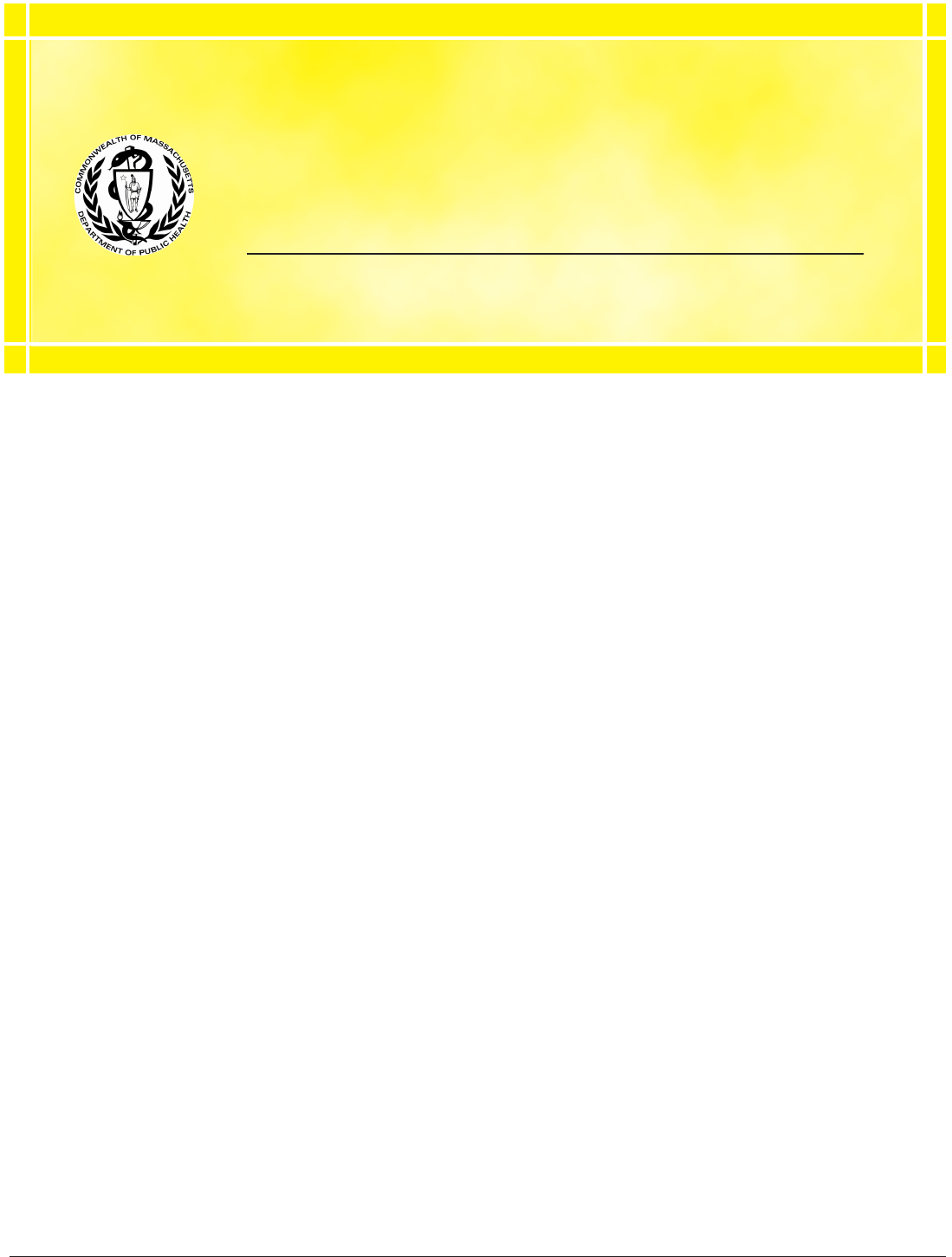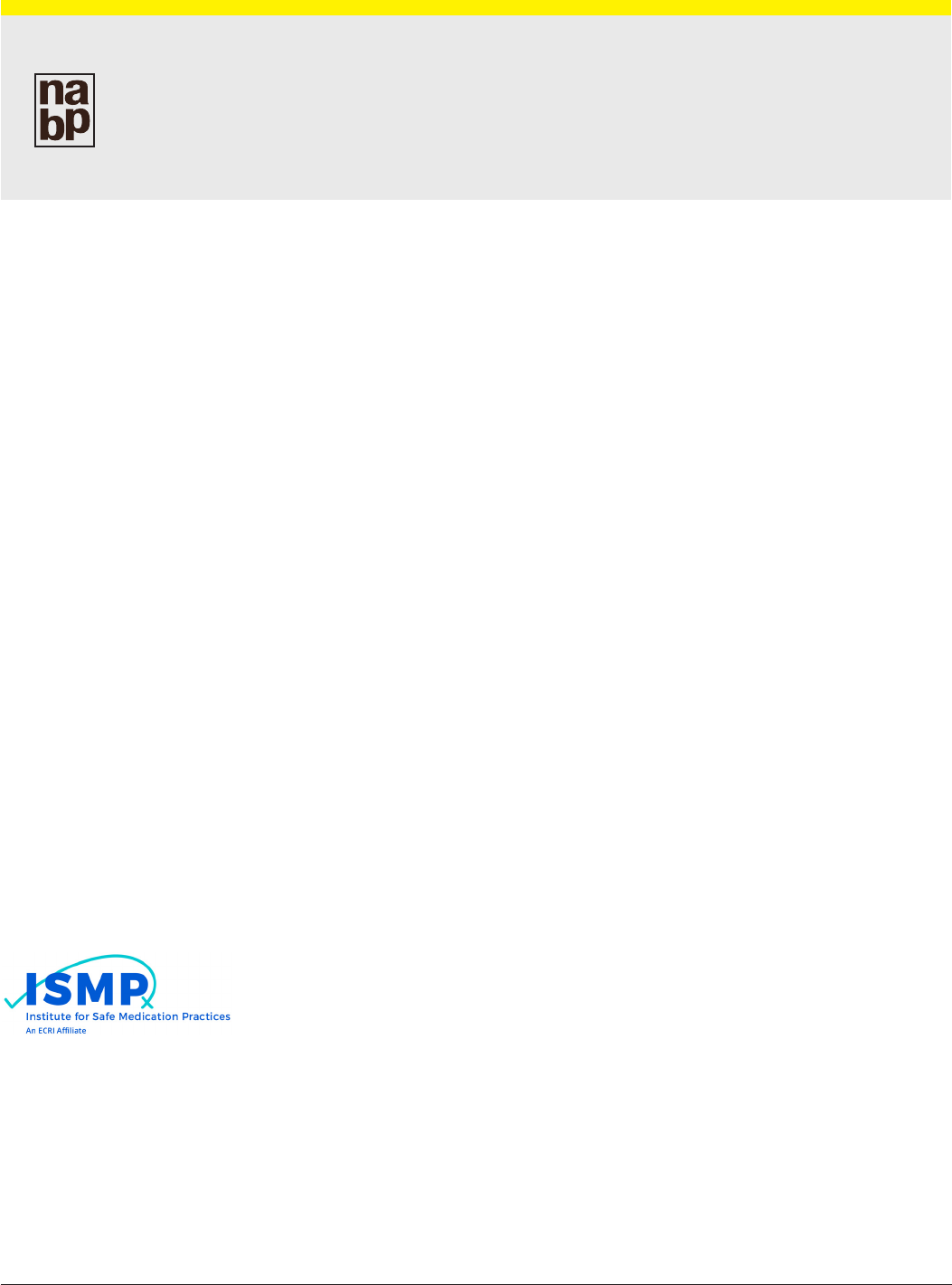
MA Vol. 4, No. 4 Page 1
Labeling
There are several content and print size labeling re-
quirements for a pharmacist lling controlled substance
(CS) prescriptions. They can be found in Massachusetts
General Laws Chapter 94C, Section 21, the United States
Pharmacopeia (USP) standards, as well as federal regula-
tions. Once they are in eect, the Massachusetts Board of
Registration in Pharmacy’s draft regulations at 247 Code
of Massachusetts Regulations 9.00 will also contain ad-
ditional labeling requirements.
Elderly persons or visually impaired persons can request
a larger print size on their prescription labels. To meet this
request, the directions on the label must be typed in a print
size not allowing more than 10 characters per inch. There
are no language stipulations, so you may label a lled
prescription in the patient’s preferred language if you have
the capacity to do so. Although not required, it would also
be helpful to provide a physical description of the drug.
In general, prescription labels axed to the container
must include the following:
♦ Pharmacy name and address
♦ Pharmacy phone number if a sterile or complex non-
sterile compounding pharmacy
♦ Serial number of the prescription
♦ Name of the patient, unless it is a veterinary prescription
♦ Name of prescriber
♦ Filling pharmacist’s initials
♦ Date of ll
♦ Name of CS, including strength or concentration
♦ When a less expensive product is substituted, the
phrase: “Interchange (or IC): Generic name of less
expensive drug plus manufacturer name”
♦ Directions for use
♦ Quantity
♦ Cautionary statements, if any
♦ Expiration date from the manufacturer’s container or
one year from the date the drug is dispensed, whichever
is earlier (USP <7>)
♦ Beyond-use-date of a compounded preparation
♦ If the prescription was compounded by the pharmacy,
a statement that the drug is either a sterile or nonsterile
compounded drug preparation
♦ For a Schedule II, III, or IV drug, the words: “Cau-
tion: Federal law prohibits the transfer of this drug
to any person other than the patient for whom it was
prescribed.”
License Status During the COVID-19
Emergency Period
Governor Charlie Baker has issued an order for licensing
allowances and extensions during the emergency period.
Below is information on license statuses, reactivation of
expired and retired licenses, and emergency reciprocity.
♦ If the license expiration date is prior to March 10,
2020, the license is expired.
♦ If the license expiration date is between March 10,
2020, and June 30, 2021, the license remains current
under the governor’s order but will expire on June 30,
2021.
♦ If the license expiration date is on or after June 30,
2021, the license is current and will expire on the
stated date.
For licenses that expired prior to March 10, 2020, but
less than two years after the expiration date, you can apply
for late renewal, using one of the following two actions:
1. Submit a paper renewal application for the coronavirus
disease 2019 (COVID-19) state of emergency only.
This temporary renewal has no fee, no renewal
requirements, and will expire 90 days after the
termination of the state of emergency.
2. Log in to the Massachusetts Department of Public
Health Online Licensing portal and complete a late
239 Causeway Street, 5
th
Floor • Boston, MA 02114 • www.mass.gov/dph/boards/pharmacy
May 2021
Published to promote compliance of pharmacy and drug law
News
Massachusetts Board
of Registration in Pharmacy
Continued on page 4

in pediatric care. Standardization limits the risk of variation,
especially when patients are transitioned from hospital to home
or have prescriptions filled at different pharmacies. However,
ISMP has learned of multiple instances in which unrecognized
differences or changes in drug concentrations led to confusion
and dosing errors.
In one example, a patient was prescribed hydroxyurea, an
antineoplastic agent. The community pharmacy compounded
a 50 mg/mL suspension for the patient with instructions to
take 13 mL (650 mg) for each dose. When the patient was
later admitted to the hospital, the inpatient pharmacy prepared
their standard concentration of 100 mg/mL, but the same
dose volume of 13 mL was ordered. As a result, the patient
received doses of 1,300 mg for several days before the error
was recognized. It is unclear why the community pharmacy
prepared a 50 mg/mL concentration. Perhaps the prescriber
ordered that concentration or that was the concentration with
which the pharmacist was most familiar.
Similar concentration mix-ups have been reported in
literature. In one case, the oral class 1c antiarrhythmic
medication flecainide was involved. The parents of a nine-
month-old infant were told to increase the child’s dose volume
of flecainide to 4 mL, assuming the concentration was 5 mg/mL
as in the original prescription.
1
However, the parents refilled
the prescription at a different pharmacy and received the drug
in a 20 mg/mL concentration. The patient received 80 mg/4
mL, a fourfold overdose, resulting in wide complex tachycardia
and QRS prolongation.
There have been efforts, including those by a collaborative
led by the University of Michigan
2
and the American Society
of Health-System Pharmacists (ASHP)
3
, to publish lists of
consensuses and literature-based standard concentrations. In
fact, for the medications involved in the cases above, both the
University of Michigan and ASHP standard recommendations
are in alignment – hydroxyurea 100 mg/mL and flecainide 20
mg/mL. However, the outreach and communication of these
standardization efforts do not appear to be reaching prescribers
and pharmacists. Both inpatient and outpatient practitioners
need to get on the same set of standard concentrations for
compounded oral liquids. It is imperative that both medical and
pharmacy professional organizations develop and implement
effective strategies to reach and influence practitioners to use
the published standard concentrations. ISMP urges prescribers
and pharmacists to review the University of Michigan and
Page 2
Guidelines, Materials Available to Health
Care Providers for Safely Administering
COVID-19 Vaccines
Guidelines and materials are available to support health care
providers with safely administering the coronavirus disease
2019 (COVID-19) vaccine, including safe practice recommen-
dations from the Institute for Safe Medication Practices (ISMP)
and a United States Pharmacopeia (USP) toolkit.
After numerous reports of errors or hazards associated with
the administration of COVID-19 vaccines, ISMP is sharing safe
practice recommendations.
A new USP toolkit is also available to facilitate operational
efficiencies that can help accelerate delivery and support safe
handling of COVID-19 vaccines while maintaining quality
and ultimately the public’s trust. Download the USP toolkit.
FDA Issues Guidance to Protect
Consumers From Methanol Poisoning
Food and Drug Administration (FDA) has issued guid-
ance for industry, Policy for Testing of Alcohol (Ethanol) and
Isopropyl Alcohol for Methanol, Including During the Public
Health Emergency (COVID-19). The guidance is intended
to help pharmaceutical manufacturers and pharmacists who
engage in drug compounding to avoid using pharmaceutical
alcohol contaminated with or substituted with methanol in
drug products. FDA noted that methanol is not an acceptable
ingredient for any drug product and should not be used. The
guidance is available on the FDA website.
Standardize Concentrations for Oral
Liquid Preparations
This column was prepared
by ISMP, an ECRI affiliate.
Have you experienced a
medication error or close
call? Report such incidents in
confidence to ISMP’s National Medication Errors Reporting
Program online at www.ismp.org or by email to ismpinfo@
ismp.org to activate an alert system that reaches manufacturers,
the medical community, and FDA. To read more about the
risk reduction strategies that you can put into practice today,
subscribe to the ISMP Medication Safety Alert! newsletters at
www.ismp.org.
Few would disagree that standardizing the concentrations of
drugs has enormous potential for increasing safety, especially
National Pharmacy Compliance News
May 2021
The applicability of articles in the National Pharmacy Compliance News to a
particular state or jurisdiction can only be ascertained by examining the law of
such state or jurisdiction.
National Association of Boards
of Pharmacy Foundation
NABPF
FOUNDATION

Page 3
ASHP lists and consider adopting the proposed standard
concentrations. Your efforts can help reduce the risk of
medication errors.
It is also important for pharmacists to provide patients
or caregivers with appropriately sized metric-only dosing
devices (eg, oral syringes) to measure and administer doses.
Label directions for patients and caregivers should include the
dose in terms of mL (not teaspoonfuls), matching the dosing
device. The community pharmacy label should also include
the concentration next to the drug name. To be sure patients
or caregivers are able to use the dosing device and measure
the proper dose, use the teach-back method to demonstrate
how to measure and administer prescribed amounts. This also
gives pharmacists, patients, and caregivers an opportunity to
catch an error.
References
1. Wang GS, Tham E, Maes J, et al. Flecainide toxicity in a
pediatric patient due to differences in pharmacy compound-
ing. Int J Cardiol. 2012;161(3):178-9.
2.
www.mipedscompounds.org/
3. www.ashp.org/-/media/assets/pharmacy-practice/s4s/docs/
Compound-Oral-Liquid.ashx
Opioid Use Disorder Educational
Programs, Resources Available for
Pharmacists
Through its Opioid Use Disorder (OUD) Education Program,
the College of Psychiatric and Neurologic Pharmacists
(CPNP) provides educational programs and resources that
can help pharmacists during the ongoing opioid epidemic.
These educational opportunities include Accreditation Council
for Pharmacy Education-approved, on-demand programs
covering subjects such as pharmacotherapy for OUD, comorbid
disorders, and chronic pain and OUD. Toolkits and guides are
available to assist pharmacists in the areas of intervention,
medication management, and naloxone access.
These educational materials and resources can be accessed
through the CPNP website.
National Diabetes Prevention Program –
How Pharmacists Can Get Involved
Pharmacists can play a key role in preventing type 2 diabetes
by helping to expand the reach of the National Diabetes Preven-
tion Program (National DPP) – a program led by the Centers for
Disease Control and Prevention (CDC) that makes it easier for
patients with prediabetes or who are at risk for type 2 diabetes
to participate in evidence-based lifestyle changing programs
to reduce their risk and improve overall health. CDC offers an
action guide for community pharmacists that outlines ways
pharmacies can raise awareness of prediabetes. The National
DPP is a partnership among private and public organizations to
screen and test for prediabetes and refer people with prediabetes
to a CDC-recognized lifestyle change program participating
in the National DPP, and deliver the National DPP lifestyle
change program. More information about how pharmacists
can participate is available on the CDC website.
Surgery Patients Receive More Opioids
in the US Than in Other Countries
Patients in the US are prescribed a disproportionally higher
number of opioids after surgeries compared to surgery patients
in other countries, according to a new study. The study, pub-
lished in the Journal of the American College of Surgeons,
reviewed data from 2,024 surgery patients and found that
83% of US patients without pain were prescribed opioids,
compared with 8.7% of non-US patients without pain. The au-
thors concluded that US patients are prescribed more amounts
of opioids at higher rates regardless of the severeness of their
post-surgical pain. The authors recommend that more efforts
are made toward ensuring that opioid prescriptions are tailored
to patients’ needs.
The full text of the study can be accessed by visting www.
journalacs.org/article/S1072-7515(20)32336-X/fulltext.
Study Finds 94% Drop in Symptomatic
COVID-19 Cases With Pfizer’s Vaccine
A study by Israel’s largest health care provider, health
maintenance organization Clalit, reported that there is a 94%
drop in symptomatic COVID-19 cases with the Pfizer vaccine.
The study represents 600,000 people who received two doses
of the Pfizer COVID-19 vaccine in Israel. Clalit, which cov-
ers more than half of all Israelis, noted the same group who
received the COVID-19 vaccine doses was also 92% less likely
to develop serious illness from the virus. The study compared
the vaccine recipient group to another group of the same size
and medical history who had not received the vaccines. Read
the full study here.
NABP Executive Director/Secretary
Addresses Pharmacists’ Involvement
in COVID-19 Vaccination During FIP
Webinar
NABP Executive Director/Secretary Lemrey “Al” Carter,
PharmD, MS, RPh, presented during the International
Pharmaceutical Federation’s (FIP’s) Regulators’ Forum on
pharmacists’ involvement with COVID-19 vaccination on
February 4, 2021. The webinar addressed a new regulatory
vaccination preparedness self-assessment tool and risk
assessment, the expanded roles for pharmacists, and data
FIP has collected on vaccinations by pharmacists. View the
webinar here.
National Pharmacy Compliance News
May 2021

renewal. The late fee will be waived; however, the
regular license renewal fee must be paid, and con-
tinuing education (CE) requirements must be met.
This renewed license will expire in ordinary course.
For licenses that expired or retired more than two
years ago but less than 10 years after the expiration date,
you can apply for reactivation using one of the following
two actions:
1. Submit a reactivation application for the COVID-19
state of emergency only. This reactivation has no
fee, no reactivation requirements, and will expire 90
days after the termination of the state of emergency.
2. Submit a routine reactivation application. The regular
license renewal fee must be paid, but any required
back-cycle fees and late fees will be waived. CE and
other requirements must be met. This reactivated
license will expire in ordinary course.
During the COVID-19 state of emergency, a
pharmacist or pharmacy technician who is licensed
to practice in another state may receive emergency
authorization to practice on behalf of a Massachusetts-
licensed pharmacy or health care facility. To do so, the
pharmacist or pharmacy technician must:
1. submit a completed application to the Board;
2. sign up for an
NABP Passport via the National
Association of Boards of Pharmacy
®
(NABP
®
);
3. receive written authorization from the Board prior
to engaging in practice; and
4. comply with all Massachusetts laws and regulations.
Impaired Operation of Vehicles
The National Transportation Safety Board (NTSB)
conducted a study about the relationship between pilot
fatalities and increased use of potentially impairing drugs
among pilots. This study brings attention to the fact that
the increase in potentially impairing drug use among pilots
is indicative of a similar trend in the general population,
and that the risk of transportation accidents is not limited
to pilots but extends to individuals operating other
types of vehicles such as boats, trains, trucks, or cars.
In addition, the study found the most common potentially
impairing drug used by pilots was diphenhydramine, the
sedating antihistamine used in many non-prescription
medications such as Benadryl
®
and Unisom
®
.
Accordingly, the Massachusetts Boards of Registration
in Dentistry, Nursing, Pharmacy, and Physician Assistants
(Boards) join the NTSB in strongly recommending that
health care providers discuss with patients the eect
that medical conditions, and any prescribed, dispensed,
or recommended medications, may have on patients’
ability to safely operate a vehicle in any mode of
transportation.
While the NTSB alert highlights this particular,
important concern, the Boards remind health care providers
that the recommended conversation should be a part of a
broader discussion with patients concerning the eects of
their medical conditions and medications.
Getting to Know Your Board Members –
Carly Jean-Francois
Carly Jean-Francois is the nurse member of the Board
and has worked as a pediatric nurse for about 20 years.
Approximately ve years ago, she decided to obtain her
nurse practitioner degree because she enjoys working with
children and their families and wanted a new opportunity
to make a dierence in their lives. Even while growing up,
she knew that she wanted to work with children in some
capacity and had considered becoming a schoolteacher.
However, having come from a family of nurses, Carly
pursued a career in pediatric nursing.
While exploring volunteer opportunities, Carly followed
a friend’s suggestion to serve on a licensing board and
has been part of the pharmacy Board for about three
years. Pharmacists serving on the Board have specialized
knowledge, experience, and training in pharmacy as well
as the laws regulating it, and Carly has found that this is
the only real dierence between pharmacist members and
nurse members. The common dedication to public service
and the mission of the Board are the same. As a nurse who
understands the important role that pharmacists and the
pharmaceutical industry play in the health and well-being
of patients, Carly can oer dierent perspectives and ideas
with her nursing background and pharmacy experiences.
Never having served on a board, Carly did not know
what to expect. At rst, she found it dicult to navigate the
terminology and laws regulating pharmacy. However, with
the “assistance and guidance of my fellow Board members
as well as my dedication to reviewing and learning all the
materials that were presented to me, I have been able to
overcome some of the challenges and continue to grow in
my knowledge of the pharmacy eld.” Serving on the Board
with the other “dedicated and hardworking professionals”
has not only given Carly a renewed appreciation for
pharmacists and the hard work that they do, it has also
strengthened her commitment to public service. Carly
feels that serving the public is a great responsibility, but
she also enjoys the in-person meetings and the camaraderie
of having lunch with fellow Board members. Now that
COVID-19 has changed the meetings to twice monthly
virtual events, she misses those interactions, but appreciates
the opportunity to stay safely at home.
Massachusetts Board of Registration in Pharmacy News
May 2021
Page 4
Continued from page 1
Continued on page 5

Page 5 – May 2021
The Massachusetts Board of Registration in Pharmacy News is published by
the Massachusetts Board of Registration in Pharmacy and the National Associa-
tion of Boards of Pharmacy Foundation
®
(NABPF
®
) to promote compliance of
pharmacy and drug law. The opinions and views expressed in this publication
do not necessarily reect the ocial views, opinions, or policies of NABPF or
the Board unless expressly so stated.
David Sencabaugh, RPh - Executive Director
Lemrey “Al” Carter, PharmD, MS, RPh - National News Editor & Executive
Editor
Amy Sanchez - Publications and Editorial Manager
May 2021
Massachusetts Board of Registration in Pharmacy News
Continued from page 4
Carly’s advice to the pharmacy Board’s licensees
“would be to be mindful at all times that every decision
that you make as a pharmacist, intern, or technician has
the potential of impacting someone’s life in a positive or
negative way. As long as it’s within your control, always
strive for a positive impact. The only way to do that is to
keep up with your education, stay abreast of the changing
laws and regulations in the eld, and exercise due diligence
and caution in the work that you do to ensure public safety
at all times.”
Did You Know?
♦ Even though e-prescribing is now required, a
pharmacist receiving an otherwise valid written or oral
prescription may dispense it without having to verify
that a waiver has been granted or that an exception
applies. Essentially, there has been no change to this
aspect of pharmacy practice!
♦ Paper reminder notices regarding license renewal will
no longer be provided. The Board will move to email
reminders in 2022, so please keep your email address
up to date.
Board Staff
David Sencabaugh, RPh ..................... Executive Director
Monica Botto, CPhT............ Associate Executive Director
William Frisch, Jr, RPh .. Director of Pharmacy Compliance
Michelle Chan, RPh ...........Quality Assurance Pharmacist
Heather Engman, MPH, JD ...............Counsel to the Board
Joanne Trifone, RPh ....Director of Pharmacy Investigations
Ed Taglieri, RPh ........ Pharmacy Substance Use Disorder
Program Supervisor
Continued on page 5
